高三英语寒假作业第二节:概要写作Summary writing课件(34张PPT)
文档属性
| 名称 | 高三英语寒假作业第二节:概要写作Summary writing课件(34张PPT) |  | |
| 格式 | zip | ||
| 文件大小 | 1.4MB | ||
| 资源类型 | 教案 | ||
| 版本资源 | 通用版 | ||
| 科目 | 英语 | ||
| 更新时间 | 2020-07-07 19:18:34 | ||
图片预览

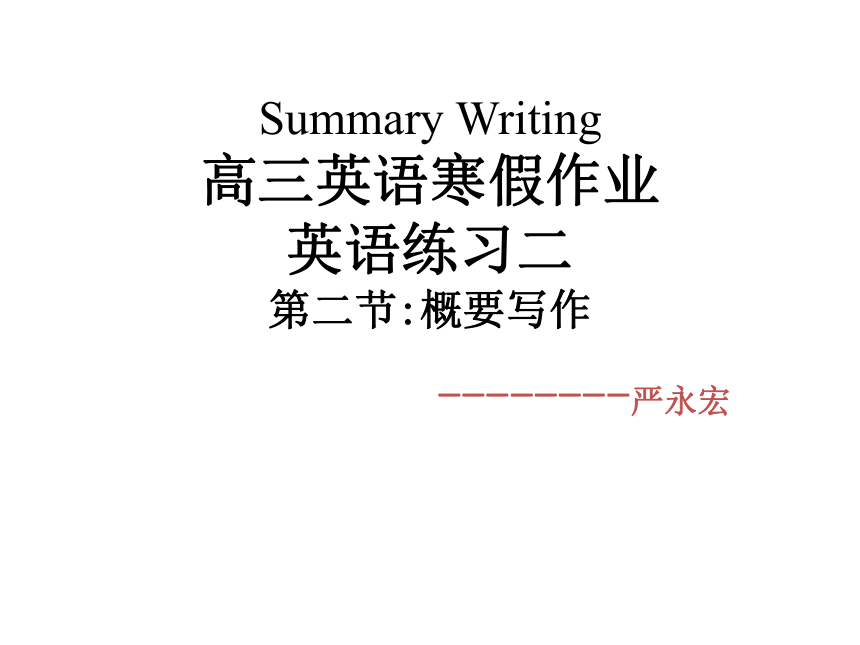

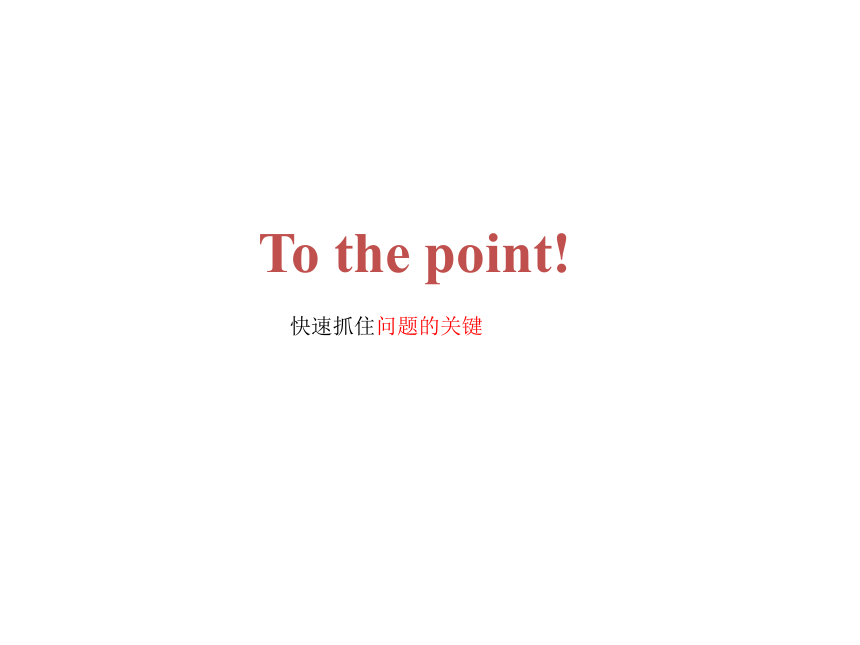
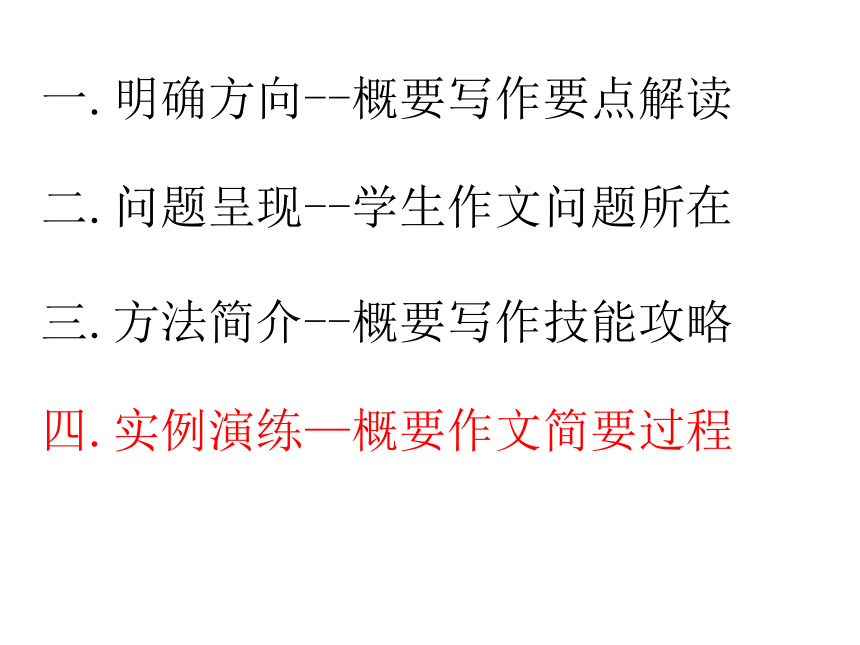

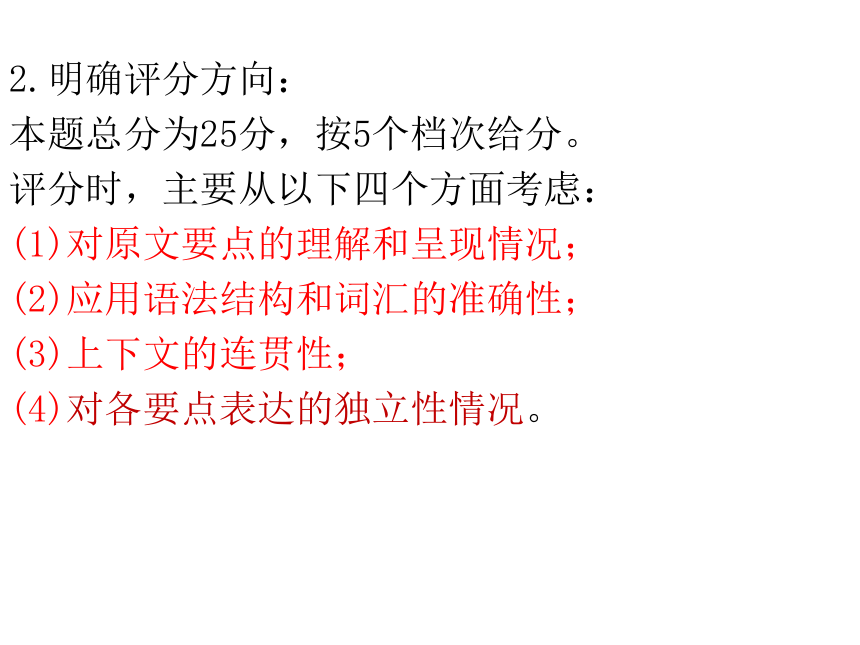

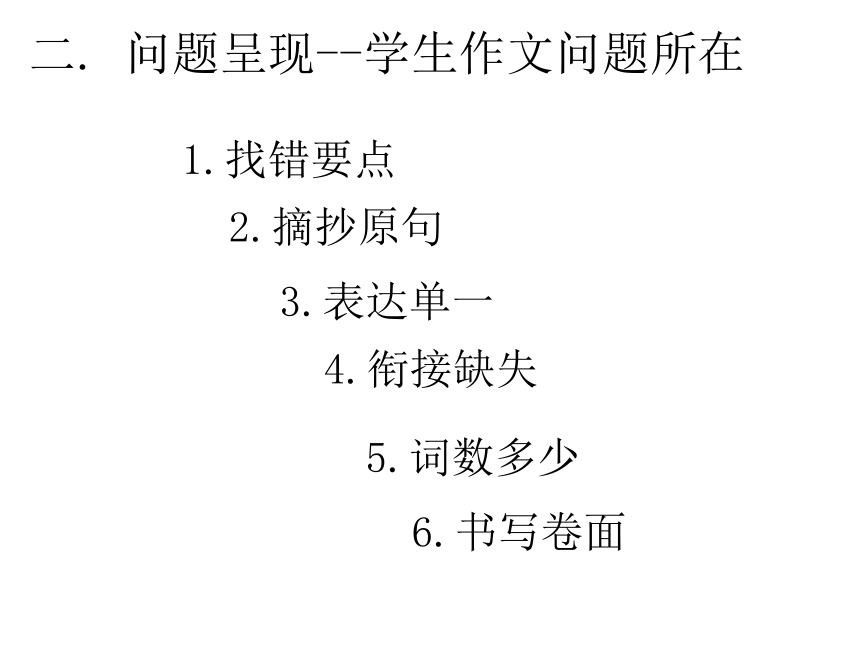
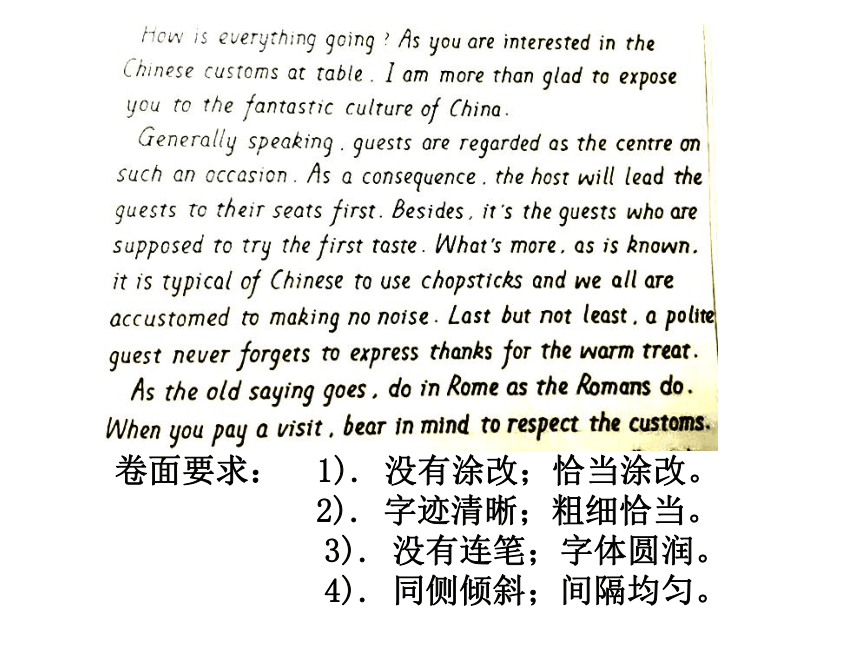
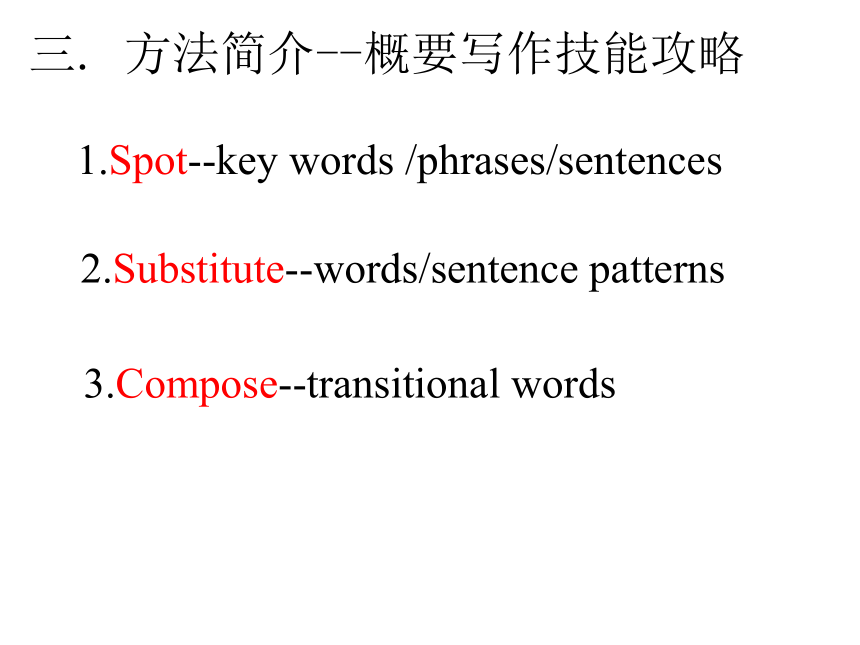
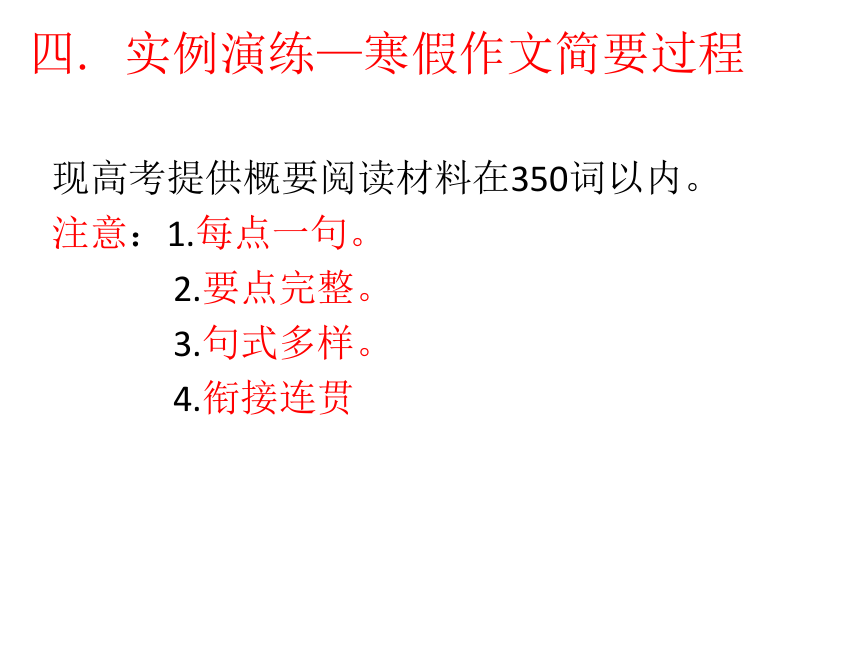
文档简介
(共34张PPT)
Summary Writing
高三英语寒假作业
英语练习二
第二节:概要写作
--------严永宏
Preventing the spread of the epidemic?
防止疫情扩散蔓延
VS
Summary writing 概要写作
To the point!
快速抓住问题的关键
一.明确方向--概要写作要点解读
二.问题呈现--学生作文问题所在
三.方法简介--概要写作技能攻略
四.实例演练—概要作文简要过程
概要写作以语篇为载体,要求学生对所提供的文本进行简要的概括。学生需要在理解文章、把握文章中心思想的基础上进行信息整合。故该题型考查学生的综合语言运用能力,即阅读能力、分析查找能力、逻辑思维能力、理解判断能力及概括能力等。
一.明确方向--概要写作要点解读
(to the point)
1.明确考查方向:
2.明确评分方向:
本题总分为25分,按5个档次给分。
评分时,主要从以下四个方面考虑:
(1)对原文要点的理解和呈现情况;
(2)应用语法结构和词汇的准确性;
(3)上下文的连贯性;
(4)对各要点表达的独立性情况。
高分方向:
第五档
(21-25)
—理解准确,涵盖全部要点。
—能准确使用相应的语法结构和词汇。
—有效地使用了语句间的连接成分,使所完成的概要结构紧凑。
—完全使用自己的语言。
第四档
(16-20)
—理解准确,涵盖绝大部分要点。
—所使用语法结构和词汇可能有些许错误,但完全不影响意义表达。
—比较有效地使用了语句间的连接成分,使所完成的概要结构紧凑。
—有个别整句抄自原文。
二. 问题呈现--学生作文问题所在
1.找错要点
2.摘抄原句
3.表达单一
4.衔接缺失
5.词数多少
6.书写卷面
卷面要求: 1). 没有涂改;恰当涂改。
2). 字迹清晰;粗细恰当。
3). 没有连笔;字体圆润。
4). 同侧倾斜;间隔均匀。
三. 方法简介--概要写作技能攻略
1.Spot--key words /phrases/sentences
2.Substitute--words/sentence patterns
3.Compose--transitional words
四. 实例演练—寒假作文简要过程
现高考提供概要阅读材料在350词以内。
注意:1.每点一句。
2.要点完整。
3.句式多样。
4.衔接连贯
第二节:概要写作(满分25分)
阅读下面短文,根据其内容写一篇60词左右的内容概要。
For many years the school system in Finland has been very successful. In the PISA survey, which compares reading, math and science knowledge of 15-year-olds around the world, Finland is not only the top European country but also competes with Asian giants like Shanghai, Singapore and South Korea. But what makes the educational system in this small country so different from others in the western countries?
Until the 1960s, most Finland’s most students left school after six years. In the middle of the 1960s, the Finnish government saw the need to change and modernize their education system if they want to be internationally competitive. Lawmakers made a simple decision: a basic school for all the 7- to 16-year-olds. Compulsory (义务的) education begins at 7. The government makes it possible for all children to attend preschool as well.
Most of Finland’s schools get their money from the government. The people who are in charge of the education system, from teachers to officials are trained teachers, not politicians like in other countries.
Teachers work with their pupils in school as much as possible. When teachers are not with the pupils, they spend a lot of time in schools working on the curriculum (课程) and new projects. Schools in Finland are small, at least for international standards. So teachers know every pupil in their school and try everything to succeed with their pupils. In contrast to other nations, Finland selects its teachers very carefully: only talented teachers go on to a university and receive a master’s degree in education. Finland only takes the best to educate its youth.
All Finnish children, whether they come from the city or the country, whether from a rich or poor family, have the same chances in education. There are not so many differences between the wealthy and the poor, as in America or other Western European countries. Education experts say that there is very little difference between very good and the worst students. Two thirds of Finnish pupils move on to higher education, the highest rate in the European Union.
?
此篇是说明文,讲述芬兰教育成功的种种原因。
Para.1
For many years the school system in Finland has been very successful. In the PISA survey, which compares reading, math and science knowledge of 15-year-olds around the world, Finland is not only the top European country but also competes with Asian giants like Shanghai, Singapore and South Korea. But what makes the educational system in this small country so different from others in the western countries?
Para.1详解:
For many years the school system in Finland has been very successful. In the PISA survey, which compares reading, math and science knowledge of 15-year-olds around the world, Finland is not only the top European country …… But what makes he educational system in this small country so different from others in the western countries?
根据语言特点来判断哪个是主题句。第一句陈述了事实, For many years the school system in Finland has been very successful. 第二句是支撑句,In the PISA survey, which compares reading, math and science knowledge……, Finland is……. 第三句出现but……,注意but后面的内容是重心。故表达应以第三句but后内容为主,第一句内容为辅,补全。 But what makes the educational system in this small country so different from others in the western countries ?此处different是more successful/better,接着下文就是陈述多种reasons。
Your sentence:
____________________________________________________________________________________________________________________________________________________
参考表达:
1.There’re multiple reasons why the Finnish educational system has been more successful than those of other Western countries.
2. Finland has a great diversity of reasons for its school system being better than those of other Western countries.
3.What makes the Finnish school system more successful than those of Western countries?
注意:第3句概要一般不用,原因是概要一般不使用问句。
Para.2
Until the 1960s, most Finland’s most students left school after six years. In the middle of the 1960s, the Finnish government saw the need to change and modernize their education system if they want to be internationally competitive. Lawmakers made a simple decision: a basic school for all the 7- to 16-year-olds. Compulsory (义务的) education begins at 7. The government makes it possible for all children to attend preschool as well.
Your sentence:
____________________________________________________________________________________________________________________________________________________
Para.2详解:
第一句介绍until the 1960s 芬兰的教育状况。第二句讲为了有国家竞争力,芬兰教育需要革新。后面几句是how to reform the educational system.
所以,后几句是重点,即compulsory education for all
the 7-and 16-year-olds and preschool kids. 关键句是后两句。Compulsory (义务的) education begins at 7. The government makes it possible for all children to attend preschool as well.
1.The success is mainly due to its compulsory education for both school and preschool children.
参考表达:
2. Its government spares no effort to make all the preschool and school kids to receive the compulsory education.
注意:此处用The success和Its government 是意义上
连接上文。
Para.3
Most of Finland’s schools get their money from the government. The people who are in charge of the education system, from teachers to officials are trained teachers, not politicians like in other countries.
Your sentence:
____________________________________________________________________________________________________________________________________________________
1.Additionally, schools are financed by the government, while the system is managed by professionals.
Para.3详解:
第三段只有2句。一是办学经费来自政府;二是学校管理人则是trained teachers not officials 。可用while对比表述。另外,前面句式多是主动语态,可考虑使用被动语态,使句式多样性。
参考表达:
2.Besides, the trained educators are in charge of schools while the government pays for the education.
注意:此处需加连接词additionally ,besides承接上文。
Para.4
Teachers work with their pupils in school as much as possible. When teachers are not with the pupils, they spend a lot of time in schools working on the curriculum (课程) and new projects. Schools in Finland are small, at least for international standards. So teachers know every pupil in their school and try everything to succeed with their pupils. In contrast to other nations, Finland selects its teachers very carefully: only talented teachers go on to a university and receive a master’s degree in education. Finland only takes the best to educate its youth.
Your sentence:
____________________________________________________________________________________________________________________________________________________
Para.4详解:
1.Teachers, well educated and carefully chosen, also devote themselves to education.
第四段前2句讲教师在校期间如何努力教学生;三四句讲芬兰班小,老师对每个学生都了解且尽力成就学生;后两句讲芬兰教师是talented teachers,而且receive higher education. Finland only takes the best to educate its youth.此句概述,即国家用最好的来教育学生。
参考表达:
注意:此处用with短语补全,使用被动句式,可使句式多样化。
2.With teachers well educated , carefully chosen and fully dedicated, the children are educated to the best of the country`s ability.
Para.5
All Finnish children, whether they come from the city or the country, whether from a rich or poor family, have the same chances in education. There are not so many differences between the wealthy and the poor, as in America or other Western European countries. Education experts say that there is very little difference between very good and the worst students. Two thirds of Finnish pupils move on to higher education, the highest rate in the European Union.
?
Your sentence:
____________________________________________________________________________________________________________________________________________________
Para.5详解:
1.Another reason is that children share equal opportunities for education.
最后一段第一句讲芬兰equal education,也是芬兰教育成功的要素。后两句是detailed information,具体说there is very little difference between very good and the worst students. 最后一句是概述芬兰教育成功结果 --Finland`s successful educational achievement.
2. Equal opportunities for all children`s education contribute to Finland`s school success as well.
参考表达:
注意:此处用as well起连接上文的作用 。
There’re multiple reasons why the Finnish educational system has been more successful than those of other Western countries. (要点1) The success is mainly due to its compulsory education for both school and preschool children. (要点2) Additionally, schools are financed by the government, while the system is managed by professionals. (要点3) Teachers, well educated and carefully chosen, also devote themselves to education. (要点4) Another reason is that children share equal opportunities for education. (要点5)
参考表达1:
Finland has a great diversity of reasons for its school system being better than those of other Western countries.(要点1) Its government spares no effort to make all the preschool and school kids to receive the compulsory education. (要点2) Besides, the trained educators are in charge of schools while the government pays for the education .(要点3) With teachers well educated , carefully chosen and fully dedicated, the children are educated to the best of the country`s ability. (要点4) Equal opportinities for all children`s education contribute to Finland`s school success as well. (要点5)
?
参考表达2:
Hopefully,it will help you a bit!
注意:
1.?概要应包括原文中的主要事实,略去不必要的细节,即要区分主要信息和次要信息,不能出现细节与实例。避免对原文进行抄袭照搬。
2.?概要写作不能对原文进行解释或评论,不可随意添加自己的观点(不能出现?“I believe”, “I think”等字句),一般用第三人称来写。
3.?概要写作并非简单罗列要点,各个要点之间要有恰当衔接,使概要衔接紧密、脉络清晰。写出的概要读起来要完整连贯、独立成篇。
4.?积累常见的同义短语和句型转换,掌握并运用单词、短语和句型,学会词汇、短语、句型的升级。
5.?注意词数是否符合要求。注意拼写、标点符号和书写的规范性。??
Concisely and perfectly!
Can I take a break ?
Homework:
Summary Writing
高三英语寒假作业
英语练习二
第二节:概要写作
--------严永宏
Preventing the spread of the epidemic?
防止疫情扩散蔓延
VS
Summary writing 概要写作
To the point!
快速抓住问题的关键
一.明确方向--概要写作要点解读
二.问题呈现--学生作文问题所在
三.方法简介--概要写作技能攻略
四.实例演练—概要作文简要过程
概要写作以语篇为载体,要求学生对所提供的文本进行简要的概括。学生需要在理解文章、把握文章中心思想的基础上进行信息整合。故该题型考查学生的综合语言运用能力,即阅读能力、分析查找能力、逻辑思维能力、理解判断能力及概括能力等。
一.明确方向--概要写作要点解读
(to the point)
1.明确考查方向:
2.明确评分方向:
本题总分为25分,按5个档次给分。
评分时,主要从以下四个方面考虑:
(1)对原文要点的理解和呈现情况;
(2)应用语法结构和词汇的准确性;
(3)上下文的连贯性;
(4)对各要点表达的独立性情况。
高分方向:
第五档
(21-25)
—理解准确,涵盖全部要点。
—能准确使用相应的语法结构和词汇。
—有效地使用了语句间的连接成分,使所完成的概要结构紧凑。
—完全使用自己的语言。
第四档
(16-20)
—理解准确,涵盖绝大部分要点。
—所使用语法结构和词汇可能有些许错误,但完全不影响意义表达。
—比较有效地使用了语句间的连接成分,使所完成的概要结构紧凑。
—有个别整句抄自原文。
二. 问题呈现--学生作文问题所在
1.找错要点
2.摘抄原句
3.表达单一
4.衔接缺失
5.词数多少
6.书写卷面
卷面要求: 1). 没有涂改;恰当涂改。
2). 字迹清晰;粗细恰当。
3). 没有连笔;字体圆润。
4). 同侧倾斜;间隔均匀。
三. 方法简介--概要写作技能攻略
1.Spot--key words /phrases/sentences
2.Substitute--words/sentence patterns
3.Compose--transitional words
四. 实例演练—寒假作文简要过程
现高考提供概要阅读材料在350词以内。
注意:1.每点一句。
2.要点完整。
3.句式多样。
4.衔接连贯
第二节:概要写作(满分25分)
阅读下面短文,根据其内容写一篇60词左右的内容概要。
For many years the school system in Finland has been very successful. In the PISA survey, which compares reading, math and science knowledge of 15-year-olds around the world, Finland is not only the top European country but also competes with Asian giants like Shanghai, Singapore and South Korea. But what makes the educational system in this small country so different from others in the western countries?
Until the 1960s, most Finland’s most students left school after six years. In the middle of the 1960s, the Finnish government saw the need to change and modernize their education system if they want to be internationally competitive. Lawmakers made a simple decision: a basic school for all the 7- to 16-year-olds. Compulsory (义务的) education begins at 7. The government makes it possible for all children to attend preschool as well.
Most of Finland’s schools get their money from the government. The people who are in charge of the education system, from teachers to officials are trained teachers, not politicians like in other countries.
Teachers work with their pupils in school as much as possible. When teachers are not with the pupils, they spend a lot of time in schools working on the curriculum (课程) and new projects. Schools in Finland are small, at least for international standards. So teachers know every pupil in their school and try everything to succeed with their pupils. In contrast to other nations, Finland selects its teachers very carefully: only talented teachers go on to a university and receive a master’s degree in education. Finland only takes the best to educate its youth.
All Finnish children, whether they come from the city or the country, whether from a rich or poor family, have the same chances in education. There are not so many differences between the wealthy and the poor, as in America or other Western European countries. Education experts say that there is very little difference between very good and the worst students. Two thirds of Finnish pupils move on to higher education, the highest rate in the European Union.
?
此篇是说明文,讲述芬兰教育成功的种种原因。
Para.1
For many years the school system in Finland has been very successful. In the PISA survey, which compares reading, math and science knowledge of 15-year-olds around the world, Finland is not only the top European country but also competes with Asian giants like Shanghai, Singapore and South Korea. But what makes the educational system in this small country so different from others in the western countries?
Para.1详解:
For many years the school system in Finland has been very successful. In the PISA survey, which compares reading, math and science knowledge of 15-year-olds around the world, Finland is not only the top European country …… But what makes he educational system in this small country so different from others in the western countries?
根据语言特点来判断哪个是主题句。第一句陈述了事实, For many years the school system in Finland has been very successful. 第二句是支撑句,In the PISA survey, which compares reading, math and science knowledge……, Finland is……. 第三句出现but……,注意but后面的内容是重心。故表达应以第三句but后内容为主,第一句内容为辅,补全。 But what makes the educational system in this small country so different from others in the western countries ?此处different是more successful/better,接着下文就是陈述多种reasons。
Your sentence:
____________________________________________________________________________________________________________________________________________________
参考表达:
1.There’re multiple reasons why the Finnish educational system has been more successful than those of other Western countries.
2. Finland has a great diversity of reasons for its school system being better than those of other Western countries.
3.What makes the Finnish school system more successful than those of Western countries?
注意:第3句概要一般不用,原因是概要一般不使用问句。
Para.2
Until the 1960s, most Finland’s most students left school after six years. In the middle of the 1960s, the Finnish government saw the need to change and modernize their education system if they want to be internationally competitive. Lawmakers made a simple decision: a basic school for all the 7- to 16-year-olds. Compulsory (义务的) education begins at 7. The government makes it possible for all children to attend preschool as well.
Your sentence:
____________________________________________________________________________________________________________________________________________________
Para.2详解:
第一句介绍until the 1960s 芬兰的教育状况。第二句讲为了有国家竞争力,芬兰教育需要革新。后面几句是how to reform the educational system.
所以,后几句是重点,即compulsory education for all
the 7-and 16-year-olds and preschool kids. 关键句是后两句。Compulsory (义务的) education begins at 7. The government makes it possible for all children to attend preschool as well.
1.The success is mainly due to its compulsory education for both school and preschool children.
参考表达:
2. Its government spares no effort to make all the preschool and school kids to receive the compulsory education.
注意:此处用The success和Its government 是意义上
连接上文。
Para.3
Most of Finland’s schools get their money from the government. The people who are in charge of the education system, from teachers to officials are trained teachers, not politicians like in other countries.
Your sentence:
____________________________________________________________________________________________________________________________________________________
1.Additionally, schools are financed by the government, while the system is managed by professionals.
Para.3详解:
第三段只有2句。一是办学经费来自政府;二是学校管理人则是trained teachers not officials 。可用while对比表述。另外,前面句式多是主动语态,可考虑使用被动语态,使句式多样性。
参考表达:
2.Besides, the trained educators are in charge of schools while the government pays for the education.
注意:此处需加连接词additionally ,besides承接上文。
Para.4
Teachers work with their pupils in school as much as possible. When teachers are not with the pupils, they spend a lot of time in schools working on the curriculum (课程) and new projects. Schools in Finland are small, at least for international standards. So teachers know every pupil in their school and try everything to succeed with their pupils. In contrast to other nations, Finland selects its teachers very carefully: only talented teachers go on to a university and receive a master’s degree in education. Finland only takes the best to educate its youth.
Your sentence:
____________________________________________________________________________________________________________________________________________________
Para.4详解:
1.Teachers, well educated and carefully chosen, also devote themselves to education.
第四段前2句讲教师在校期间如何努力教学生;三四句讲芬兰班小,老师对每个学生都了解且尽力成就学生;后两句讲芬兰教师是talented teachers,而且receive higher education. Finland only takes the best to educate its youth.此句概述,即国家用最好的来教育学生。
参考表达:
注意:此处用with短语补全,使用被动句式,可使句式多样化。
2.With teachers well educated , carefully chosen and fully dedicated, the children are educated to the best of the country`s ability.
Para.5
All Finnish children, whether they come from the city or the country, whether from a rich or poor family, have the same chances in education. There are not so many differences between the wealthy and the poor, as in America or other Western European countries. Education experts say that there is very little difference between very good and the worst students. Two thirds of Finnish pupils move on to higher education, the highest rate in the European Union.
?
Your sentence:
____________________________________________________________________________________________________________________________________________________
Para.5详解:
1.Another reason is that children share equal opportunities for education.
最后一段第一句讲芬兰equal education,也是芬兰教育成功的要素。后两句是detailed information,具体说there is very little difference between very good and the worst students. 最后一句是概述芬兰教育成功结果 --Finland`s successful educational achievement.
2. Equal opportunities for all children`s education contribute to Finland`s school success as well.
参考表达:
注意:此处用as well起连接上文的作用 。
There’re multiple reasons why the Finnish educational system has been more successful than those of other Western countries. (要点1) The success is mainly due to its compulsory education for both school and preschool children. (要点2) Additionally, schools are financed by the government, while the system is managed by professionals. (要点3) Teachers, well educated and carefully chosen, also devote themselves to education. (要点4) Another reason is that children share equal opportunities for education. (要点5)
参考表达1:
Finland has a great diversity of reasons for its school system being better than those of other Western countries.(要点1) Its government spares no effort to make all the preschool and school kids to receive the compulsory education. (要点2) Besides, the trained educators are in charge of schools while the government pays for the education .(要点3) With teachers well educated , carefully chosen and fully dedicated, the children are educated to the best of the country`s ability. (要点4) Equal opportinities for all children`s education contribute to Finland`s school success as well. (要点5)
?
参考表达2:
Hopefully,it will help you a bit!
注意:
1.?概要应包括原文中的主要事实,略去不必要的细节,即要区分主要信息和次要信息,不能出现细节与实例。避免对原文进行抄袭照搬。
2.?概要写作不能对原文进行解释或评论,不可随意添加自己的观点(不能出现?“I believe”, “I think”等字句),一般用第三人称来写。
3.?概要写作并非简单罗列要点,各个要点之间要有恰当衔接,使概要衔接紧密、脉络清晰。写出的概要读起来要完整连贯、独立成篇。
4.?积累常见的同义短语和句型转换,掌握并运用单词、短语和句型,学会词汇、短语、句型的升级。
5.?注意词数是否符合要求。注意拼写、标点符号和书写的规范性。??
Concisely and perfectly!
Can I take a break ?
Homework:
